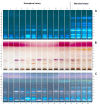The comparison of the antioxidant, antibacterial and antiviral potential of Polish fir honeydew and Manuka honeys
- PMID: 39732871
- PMCID: PMC11682447
- DOI: 10.1038/s41598-024-82429-0
The comparison of the antioxidant, antibacterial and antiviral potential of Polish fir honeydew and Manuka honeys
Abstract
The aim of the present study was to compare the antioxidant, antibacterial and antiviral activities of Podkarpackie coniferous honeydew honey and Manuka honey. The quality of tested honey samples (honeydew-12 and Manuka-4) regarding honey standard was evaluated as well as additional indicators (methylglyoxal, total phenolics and HPTLC phenolic profile, antioxidant potential, glucose oxidase activity, and hydrogen peroxide) were compared. Antibacterial potential was analyzed against Gram-positive (S. aureus and B. cereus) and Gram-negative (E. coli and S. enterica) bacteria. Antiviral activity against different RNA (phi6, MS2) and DNA (T7, phiX174) bacteriophages considered as "viral surrogates" was determined. Based on the determined physicochemical parameters the good quality of tested honeys was confirmed, excluding two samples. The content of polyphenolic compounds in honeydew honey ranged from 583.87 to 1102.42 mg of gallic acid/kg and was strongly correlated with the antioxidant properties. Moreover, for samples with the strongest activity these parameters were comparable to Manuka honey. However, the obtained HPTLC polyphenolic profiles were completely different for honeydew than for Manuka honey which exhibited additional bands (Rf = 0.74 and 0.52). Honeydew honeys were characterized by a strong antiviral and antibacterial properties most of all against Gram-positive bacteria. The MICs (minimal inhibitory concentrations) for S. aureus and B. cereus ranged 15-35% and 8-15% for honeydew and Manuka honeys, respectively. The strongest antiviral properties of honeydew honey were demonstrated mainly against RNA bacteriophages (phi6, MS2) which was even higher than for Manuka honey, especially against MS2 virus. The obtained results suggest that Podkarpackie honeydew honey with the controlled glucose oxidase activity may be a natural substance used to combat viral and bacterial diseases.
Keywords: Antibacterial; Antioxidants; Antiviral; Bacteriophages; GOX; Honeydew honey; Hydrogen peroxide; Manuka Honey; Polyphenols.
© 2024. The Author(s).
Conflict of interest statement
Declarations. Competing interests: The authors declare no competing interests.
Figures







References
-
- Nathanson, N. The human toll of viral diseases: past plagues and pending pandemics. Viral Pathogenesis. 3, 16. 10.1016/B978-0-12-800964-2.00001-X (2016).
-
- Dustman, J. H. Antibacterial effect honey. Apiacta14, 7–11 (1979).
Publication types
MeSH terms
Substances
Grants and funding
LinkOut - more resources
Full Text Sources
Medical
Molecular Biology Databases

